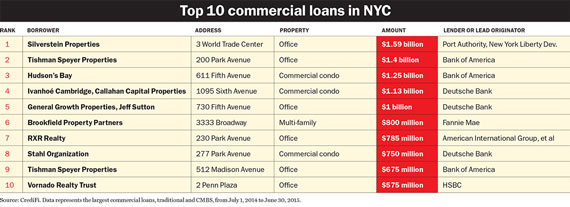Trending
CMBS borrowing up sharply
Half of top 10 commercial loans </br>over past 12 months did not </br>come from banks

Top commercial owners on the hunt for low-cost financing are increasingly turning to the more restrictive terms of securitized loans over more flexible options, fueling a sharp rise in commercial mortgage-backed securities lending over the past year.
Companies such as Tishman Speyer and Saks Fifth Avenue parent Hudson’s Bay Co. are returning in force to CMBS loans, leading to a 34 percent increase in such borrowing in New York City during the 12 months ended June 30, to $13.6 billion.
Still, five of the top 10 loans were non-CMBS. Landlords such as General Growth Properties, investor Jeff Sutton and Vornado Realty Trust chose instead to borrow from a bank or life insurance company that will hold the loans on their books, or sell pieces to other lenders.
The Real Deal reviewed the top 10 financing deals issued over the past year, compiled by real estate debt-tracking firm CrediFi. The securitized loan data firm Trepp identified the CMBS loans among them. (See related chart on page 106.)
Among the top 10, the five CMBS deals totaled $5.2 billion. The others, which totaled $4.8 billion, were a combination of balance sheet, syndicated loans and one life insurance company-backed deal.
[vision_pullquote style=”3″ align=”center”]
[/vision_pullquote]
The banks and originators were the typical players in the commercial real estate space, including the German lender Deutsche Bank and Bank of America.
The largest deal was a $1.59 billion bond offering to refinance loans on 3 World Trade Center. The Port Authority of New York and New Jersey and New York Liberty Development, an arm of the Empire State Development Corp., issued the bonds in October on behalf of Larry Silverstein’s Silverstein Properties.
Some of the large loans on the list do not reflect the total amount of debt the owner took on for specific properties. For example, General Growth and Sutton borrowed a total of $1.25 billion from Deutsche Bank in April for the acquisition of 730 Fifth Avenue, but only $1 billion was secured and included in the top 10. Deutsche Bank sold off the other $250 million as mezzanine debt, which is a type of debt that carries a higher interest rate and is less secure than a first mortgage.
Absent from the list were some foreign banks that have been active in construction or other sectors, but not in the largest loans in New York, for example the Bank of China.
“Foreign banks are still active,” said Ronnie Levine, senior managing director of commercial brokerage Meridian Capital Group. But he said they are more focused in construction lending.
“It could be after several years of large lending, their strategy shifted to spreading risk over more properties with smaller financing deals,” said Clayton Rifkind, head of marketing for CrediFi.
Not all the lenders were banks or CMBS bond holders. Insurer American International Group originated a $785 million acquisition loan, given to RXR Realty for the purchase of Midtown tower 230 Park Avenue on May 5.
Also driving lending in the market is the looming rise in interest rates, which most expect to happen in the coming months or years, although no one is sure when.
“Borrowers want to lock in the lower rates,” said Sean Barrie, a research analyst at Trepp.
Mortgage lending professionals said CMBS loans are more restrictive.
“Most borrowers will choose a balance sheet lender any day over a CMBS lender,” said Gregg Winter, managing partner of Winter & Company Commercial Real Estate Finance. He noted that CMBS often has high prepayment penalties or other restrictions that make it more difficult to modify the loan after closing than traditional loans. “There’s no comparison between the post-closing flexibility that’s available to a borrower.”




